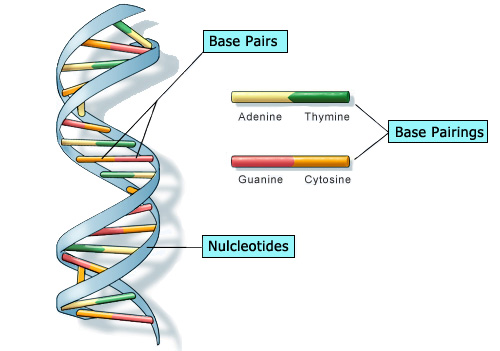Molecular Biology - DNA
Base Pairs
Within the DNA molecule, there are four bases from two biochemical classes. The purines are guanine (G) and adenine (A). The pyrimidines are cytosine (C) and thymine (T). Another pyrimidine base is uracil (U) that is only present in RNA.
Within the DNA molecule, there are four bases from two biochemical classes. The purines are guanine (G) and adenine (A). The pyrimidines are cytosine (C) and thymine (T). Another pyrimidine base is uracil (U) that is only present in RNA.
Base Pairings
The four bases can combine in only two ways. G binds with C through three hydrogen bonds, and A binds with T through two hydrogen bonds. Thus there are only two possible base pairings.
The four bases can combine in only two ways. G binds with C through three hydrogen bonds, and A binds with T through two hydrogen bonds. Thus there are only two possible base pairings.
Nucleotides
Nucleotides are the building blocks of DNA and RNA they consist of a base (G, A, C, T [U]), sugar (deoxyribose or ribose) and a phosphate group. Nucleotides bind together to form a long polymer molecule, which will form one half of the DNA molecule. The specific sequence of nucleotides along a strand determines the genetic code carried by the organism.
Nucleotides are the building blocks of DNA and RNA they consist of a base (G, A, C, T [U]), sugar (deoxyribose or ribose) and a phosphate group. Nucleotides bind together to form a long polymer molecule, which will form one half of the DNA molecule. The specific sequence of nucleotides along a strand determines the genetic code carried by the organism.
Exon:
The region of a gene that contains the code for producing the gene’s protein. Each exon codes for a specific portion of the complete protein. In some species (including humans), a gene’s exons are separated by long regions of DNA (called introns or sometimes “junk DNA”) that have no apparent function.
The region of a gene that contains the code for producing the gene’s protein. Each exon codes for a specific portion of the complete protein. In some species (including humans), a gene’s exons are separated by long regions of DNA (called introns or sometimes “junk DNA”) that have no apparent function.
Intron:
A noncoding sequence of DNA that is initially copied into RNA but is cut out of the final RNA transcript.
A noncoding sequence of DNA that is initially copied into RNA but is cut out of the final RNA transcript.
Non-coding DNA:
The strand of DNA that does not carry the information necessary to make a protein. The non-coding strand is the mirror image of the coding strand and is also known as the antisense strand.
The strand of DNA that does not carry the information necessary to make a protein. The non-coding strand is the mirror image of the coding strand and is also known as the antisense strand.
Move your mouse over each label for a description.

Deoxyribonucleic acid (DNA) is a nucleic acid that contains the genetic instructions used in the development and functioning of all known living organisms and some viruses.
Relevant Definitions:
